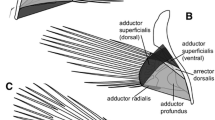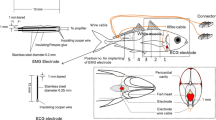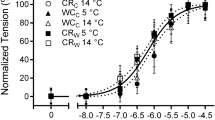Summary
-
1.
Parameters of the isometric twitch were measured for the pectoral fin adductor muscles of goldfishCarassius auratus acclimated to 10°C or 28°C. Contractile parameters and myofibrillar ATPase activities were measured at a range of temperatures. The muscle fibre composition was measured for transverse sections of pectoral fin adductor muscles from goldfish acclimated to 10°C or 28°C.
-
2.
Cold acclimation was associated with an increase in the proportion of oxidative fibre types. Muscles from cold acclimated fish had an average of 23% more red and pink fibres than muscles from warm acclimated fish.
-
3.
Cold acclimated fin muscles also possessed a significantly higher myofibrillar ATPase activity than warm acclimated fin muscles. This difference was greatest at lower measurement temperatures.
-
4.
Muscles from cold acclimated fish were able to maintain quicker rates of contraction and relaxation at low environmental temperatures, as shown by the possession of significantly shorter response times.
-
5.
The temperature dependence (Q10) of the isometric twitch contratile parameters for fin muscle from warm or cold acclimated goldfish was similar over the temperature range 20–30°C. However, over the temperature range 6–15°C fin muscles from warm acclimated goldfish possessed consistently higher Q10's.
Similar content being viewed by others
Abbreviations
- SDH:
-
Succinic dehydrogenase
References
Akster HA (1985) Morphometry of muscle fibre types in the carp (C. carpio L.). Cell Tissue Res 241:193–201
Andersen P, Henriksson J (1977) Training induced changes in the subgroups of human type II skeletal muscle fibres. Acta Physiol Scand 99:123–125
Barany M (1967) ATPase activity of myosin correlated with speed of muscle shortening. J Gen Physiol 50:197–219
Flitney FW, Johnston IA (1979) Mechanical properties of isolated fish red and white muscle fibres. Proc Physiol Soc (Lond) 295:49–50
Granzier HLM, Wiersma J, Akster HA, Osse JWM (1983) Contractile properties of a white- and a red-fibre type of the m. hyohyoideus of the carp (Cyprinus carpio L.). J Comp Physiol 149:441–449
Hazel JR (1972) The effect of temperature acclimation upon SDH activity from the epaxial muscle of the common gold-fish (C. auratus L.). Comp Biochem Physiol 43B:837–882
Hazel JR, Prosser CL (1974) Molecular mechanisms of temperature compensation in poikilotherms. Physiol Rev 54:620–677
Heap SP, Goldspink G (1986) Alterations to the swimming performance of carpCyprinus carpio as a result of temperature change. J Fish Biol 29:747–753
Heap SP, Watt PW, Goldspink G (1985) Consequences of thermal change on the myofibrillar ATPase of five freshwater teleosts. J Fish Biol 26:733–738
Hill AV (1951) The influence of temperature on the tension developed in an isometric twitch. Proc R Soc (Lond) 138B:349–35
Johnston IA, Lucking, M (1978) Temperature induced variation in the distribution of different types of muscle fibre in the goldfishC. auratus. J Comp Physiol 124:111–116
Johnston IA, Maitland, B (1980) Temperature acclimation in crucian carpCarassius carassius, morphometric analyses of muscle fibre ultrastructure. J Fish Biol 17:113–125
Johnston IA, Davison W, Goldspink G (1975) Adaptations in Mg-activated myofibrillar ATPase activity induced by temperature acclimation. FEBS Lett 50:293–295
Johnston IA, Sidell B, Driedzic WR (1985) Force-velocity characteristics and metabolism of carp muscle fibres following temperature acclimation. J Exp Biol 119:239–249
Jones PL, Sidell BD (1982) Metabolic responses of striped bassMorone saxatilis to temperature acclimation. Alterations in metabolic carbon sources and distributions of fibre types in locomotory muscle. J Exp Zool 219:163–172
Meddis R (1975) A statistical handbook for non-statisticians. McGraw-Hill,
Nachlas MM, Tsou KC, De Souza E, Cheng CS, Seligman AM (1956) Cytochemical demonstration of SDS by the use of a new p-nitrophenyl substituted ditetrazole. J Hist Cyto 5:420–436
Penney RK, Goldspink G (1979) Temperature adaptation of sarcoplasmic reticulum of fish muscle. J Therm Biol 5:63–68
Penney RK, Goldspink G (1981) Temperature adaptation by the myotomal muscle of fish. J Therm Biol 6:297–306
Renaud JM, Stevens ED (1981a) Effect of acclimation temperature and pH on contraction of frog sartorius muscle. Am J Physiol 240:301–309
Renaud JM, Stevens ED (1981b) The interactive effects of temperature and pH on the isometric contraction of toad sartorius muscle. J Comp Physiol 145:67–71
Rome LC, Loughna PT, Goldspink G (1985) Temperature acclimation: Improved sustained swimming performance in carp at low temperatures. Science 228:194–196
Smit H, Van Den Berg RJ, Kijn-Den Hartog I (1974) Some experiments on thermal acclimation in the goldfishCarassius auratus. Neth J Zool 24:32–49
Watt PW (1982) Changes in protein metabolism and histochemical properties of skeletal muscle during exercise. PhD thesis, University of Hull
Winegrad S (1968) Intracellular calcium movements of frog skeletal muscle during recovery from tetanus. J Gen Physiol 51:65–83
Winegrad S (1970) The intracellular site of calcium activation of contraction in frog skeletal muscle. J Gen Physiol 55:77–88
Author information
Authors and Affiliations
Rights and permissions
About this article
Cite this article
Heap, S.P., Watt, P.W. & Goldspink, G. Contractile properties of goldfish fin muscles following temperature acclimation. J Comp Physiol B 157, 219–225 (1987). https://doi.org/10.1007/BF00692366
Accepted:
Issue Date:
DOI: https://doi.org/10.1007/BF00692366




